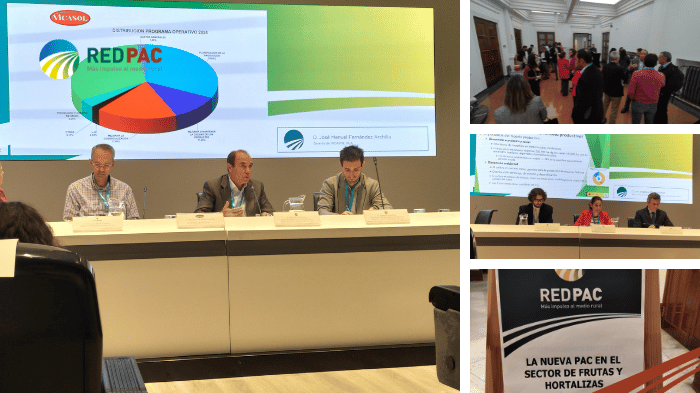
11 de April de 2024
Dinamización rural
On April 3, the CAP Network organized the "Conference on the New CAP in the Fruit and Vegetable Sector," where all stakeholders were informed about the changes in the aid previously received by the fruit and vegetable sector.
- The CAP Network is organizing a conference to inform the fruit and vegetable sector about the new CAP 2023-2027 aid options.
- The new CAP introduces changes to the aid previously received by the fruit and vegetable sector, both in operational programs and in direct payments.
Spain is Europe's leading producer of fruits and vegetables, as well as the fourth largest exporter and marketer of them in the world. With these figures, it is necessary to explain to the sector the new opportunities presented by the 2023-2027 CAP , which has introduced changes to both operational programs and direct payments.
For this reason, the CAP Network organized a workshop on April 3 for individual fruit and vegetable producers, fruit and vegetable producer organizations and their members (FPOs), fruit and vegetable producer associations, representative producer associations (AOPFHs), and regional government technicians. The workshop provided a detailed overview of all the changes introduced by the new CAP in this sector, including:
- Greater scope for Member States in applying eligibility and management criteria.
- Annual and multi-annual evaluations of results , without changing the budgetary framework.
- Programming period defined in the Operational Programmes (OPs) : there is nothing beyond the CAP financial framework after 2027.
In addition, further CAP measures for the sector were presented, such as:
- Direct payments (which include eco-regimes).
- Rural development: cooperation, investments, etc.
- Sectoral strategy.
The day served as an opportunity to reflect on the new CAP currently underway and its next steps :
- Complete the transition from Operational Programmes to the CAP Strategic Plan (PEPAC) .
- Simplification of the CAP.
- Strengthen cooperation among farmers.
- Improving the food chain.
Spain, leader in the sector
The event highlighted Spain's importance in the global fruit and vegetable sector. The sector in our country offers a wide variety of products, with more than 80 products and a wide range of production methods (intensive, extensive, irrigated, dryland, etc.), covering a broad production calendar. This is also reflected in the area of fruit and vegetables cultivated in Spain, which amounts to 1,800,723 hectares, yielding approximately 26 million tons of production ( Source: Areas and annual production. Ministry of Agriculture, Fisheries and Food (MAPA ) ).
With these figures, the PEPAC in Spain maintains for the sector:
- Support for multi-year Operational Programmes (OPs), without a financial ceiling.
- Crisis management measures.
- Calculation of aid based on the value of marketed production (VPC).
And what new features does PEPAC offer for the sector?
• The Fruit and Vegetable Sector Intervention is part of the National Strategic Plan (PEPAC).
• Greater environmental ambition.
• Greater subsidiarity .
• Changes in some aid intensities: in research and development, environment and increased consumption.
Organizations speak out
The event gave voice to some of the producer organizations and their operational programs, such as VICASOL and AOP APROA . Both presented their day-to-day work based on their own Operational Programs. The organizations agreed on a call for a reduction in the bureaucratic justifications requested by the PEPAC.
Agricultural technicians also participated, sharing their practical experiences running their farms. Specifically, Alejandro García, a farmer and winemaker at UPA Castilla La Mancha, and David Sarmiento and Sherezade Mº Paterna, both from TROPS. This was the moment when the topic of sustainability came to the forefront, and the Ministry of Agriculture, Fisheries, and Food explained the concept of ecoregimes .
In both cases, they explained the best practices they follow to maintain healthy soils, among which they defended the benefits of using groundcovers for the types of crops they grow: vineyards and avocados, respectively.
In the coming days, you can find all the material used during the day at the following link .









